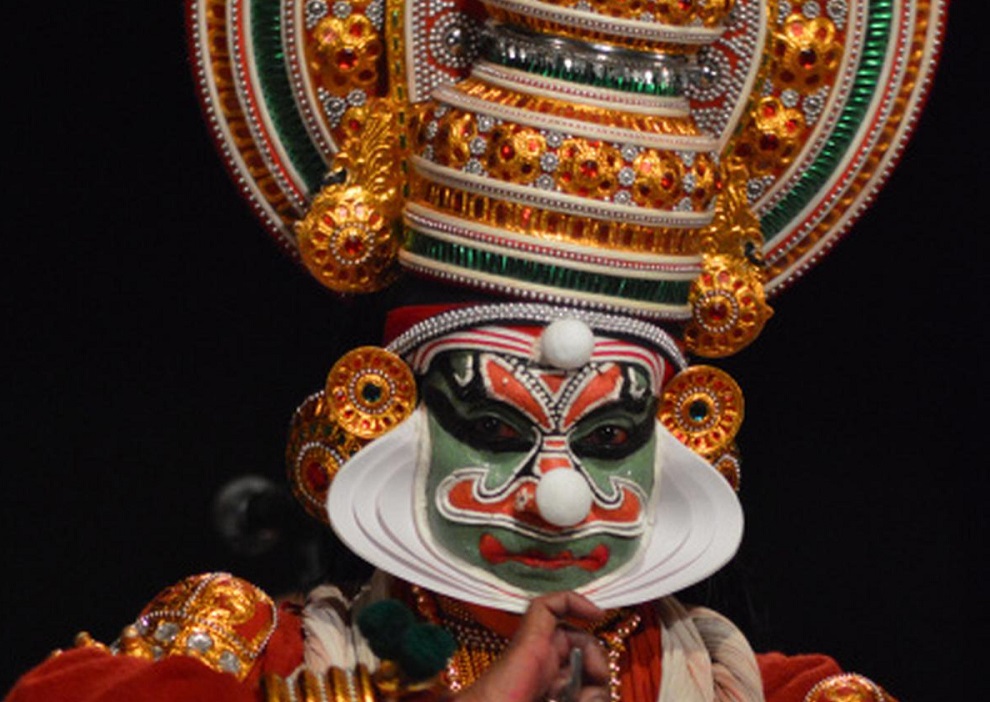With the passing of Kathakali maestro Vazhenkada Vijayan, the legacy of the Vazhenkada style of Kathakali diminishes as followers decrease.
Pattikkamthodi Ravunni Menon is considered the father of the modern form of Kathakali. His strict discipline in maintaining perfection in body movements and the proper use of ‘mudras’ earned him this title. While not a versatile performer on stage, his contributions to training methods and authentic principles in preserving energy while performing gave him a special place in modern Kathakali. Vazhenkada Kunju Nair, one of Ravunni Menon’s senior disciples, followed his master’s theories, emphasizing discipline in physical movements while also focusing on the emotional depth of the character. Kunju Nair attempted to balance both aspects of performance, dividing them into ‘mind and body.’ His deep knowledge of ‘puranas’ and related topics aided in character portrayal on stage.
During a time when Kathakali needed revival in all aspects—acting, music, and percussion—Kunju Nair led the way. He introduced new ‘manodharma renditions’ and character-focused enactment techniques, collaborating with colleagues like Kalamandalam Neelakandan Nambissan (music) and Kalamandalam Krishnan Kutti Poduval (chenda). His approach to popular Kathakali plays such as ‘Nalacharitham,’ ‘Rukmangadha Charitham,’ and ‘Santhanagoplam’ differed significantly from others. He adeptly managed technical intricacies in disciplined plays like ‘Kottayam Katha,’ ‘Narakasuravadhom,’ and ‘Ravanolbhavan,’ balancing them with attention to character.
Vazhenkada style of character enactment
Kunju Nair not only sought to popularize this new style of character-oriented enactment but also trained the next generation of performers. His main disciples, including Kottakkal Krishnankutti Nair, Kottakkal Sivaraman, Vazhenkada Vijayan, Nelliyode Vasudevan Nambudiri, Kalamandalam Vasu Pisharodi, and Kalamandalam E Vasudevan, followed their master’s teachings in various forms. Kunju Nair emphasized the importance of characterized acting styles to his disciples, preparing them for such performances. This style of performance came to be known as the ‘Vazhenkada way’ of enacting in Kathakali.
Krishnankutti Nair, among his students, became the head of Kottakkal P S V Natyasamgham, serving several years as the principal and artist. His mastery in controlling the ‘Kalari’ was renowned during that period. Kottakkal Sivaraman, gifted in female roles, became famous for his diverse acting styles focusing on character emotions. Kunju Nair’s son and disciple, Vazhenkada Vijayan, followed in his father’s footsteps in teaching and became a respected academician during his tenure at Kerala Kalamandalam. Though an excellent teacher, Vijayan also excelled on stage in selected roles such as ‘Kathi’ and ‘Vellathadi.’
Top performers
Nelliyode Vasudevan Namboodiri and Kalamandalam Vasu Pisharodi stood out as top performers produced by the ‘Vazhenkada school.’ Nelliyode focused on ‘Chuvannathadi’ and ‘Kari’ roles, while Pisharodi concentrated on roles his master had performed, becoming a true follower of Kunju Nair in portraying ‘Pacha,’ ‘Kathi,’ and ‘Minukku’ veshams. Nelliyode’s enactments in roles such as ‘Kali,’ ‘Thrigarthan,’ ‘Bali,’ and ‘Veerabhadran’ were not merely stage performances but balanced ‘puranic’ adaptation and deep knowledge. Pisharodi, in his performances of major roles like ‘Nala-Bahuka,’ ‘Dharmaputhra,’ ‘Rukmangadha,’ ‘Brahmana,’ ‘Bheema,’ and ‘Kathi’ roles such as ‘Keechaka,’ ‘Ravana,’ and ‘Narakasura,’ focused on the emotional journey of the character, supported by scholarly interpretations.
Another disciple, Kalamandalam E Vasudevan, though not employed as a teacher or artist in an institution, popularly known as ‘Vasu mash,’ did justice to the training he received in the ‘Vazhenkada way.’ He is the sole artist alive today directly tutored by Kunju Nair. However, due to age and health issues, Vasu mash has not performed on stage for several years.
As time progresses, the Vazhenkada way in Kathakali may fade due to a lack of followers. While some disciples of Vasu Pisharodi and Vijayan attempt to uphold this method, most young artists prefer the popular performance style. Nowadays, only a few artists attempt to follow Kunju Nair’s style in specialist roles like ‘Brahmana’ in ‘Santhanagopalam,’ ‘Bahuka’ in ‘Nalacharitham,’ and ‘Ravana’ in ‘Ravanolbhavam.’ It is saddening to witness the disappearance of this legendary style from stages due to a lack of proper followers.


3 Comments
This is a serious concern. The spirit of the style needs to be assimilated by the New Gen performers and teachers. Worthy of further attention by Kalamandalam and other leading institutions in the field.
Very true
Any system when observed closely tell us of its depreciation in its value system. Would Kathakali, or more specifically the said style, be an exception to this phenomenon? The techniques for maintaining the energy levels (which the author has referred to) while enacting different characters can be built only on the available infrastructure; genetic as well as trained. “Shareeramaadhyam ghalu dharmasadham” is an absolute scientifically acceptable statement. Various shaastras on natya have specified the significance of this practical wisdom.There are several suggestions from various schools of body kinematics and kniesics to ensure this at general and individual levels. What specially is updated and included in the training system in the different kalaris? If done, have they been approved by those who have sufficient professional knowledge how of the subject concerned?